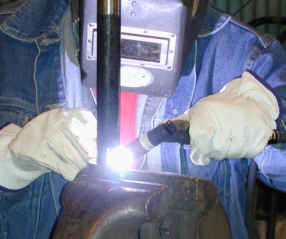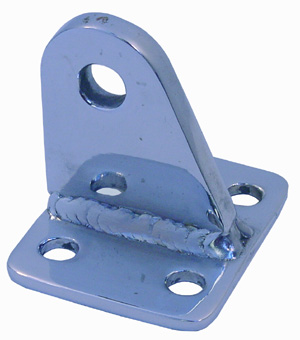Tungsten inert gas welding
From DDL Wiki
Contents |
Process
In TIG welding, two similar metals are placed adjacent to one another. The TIG operator then attaches a grounding strap to one or both of the pieces of metal. Using a foot pedal which regulates current, the operator applies high-amperage electrical current to the joint line along which the two parts are to be welded. The current is applied using a TIG torch, which usually consists of an insulating handle which houses a hollow tungsten electrode which is sharpened to a fine point (for steel welding) or a rounded point (for aluminum). Additionally, the torch contains a gas feed line which leads to the hollow electrode. Inert gas at pressure is fed through this line, to the electrode, and then over the hot metal; this prevents oxidation and contamination of the metal at the joint.
The intense heat generated by the metal’s natural resistance to current melts the two pieces along the joint line in close proximity to the electrode. As the operator moves the torch down the joint, he will intermittently apply additional metal by introducing a thin rod of similar metal into the arc between the torch’s electrode and the joint. Addition of this filler rod serves several purposes: first, it ensures consistent material thickness at the weld joint. Also, adding filler metal at the joint ensures retention of mechanical properties at the joint, whether for bearing load or sealing gasses and liquids in containers or pipes. Finally, adding filler allows the TIG operator to ensure proper weld penetration on thicker joints by first beveling both pieces at the joint and then building up filler in this joint.
After the operator has finished welding the joint, the TIG torch is left over the hot metal for a small amount of time without applying any current. This ensures that the remaining mass of molten metal cools completely while cloaked by the inert gas.
Materials
TIG welding can be applied to almost any common structural or load-bearing metals. These include (but are not limited to): aluminum alloys, steel and other iron alloys, magnesium alloys, and copper alloys. Special considerations need to be made for each metal. Sheilding gas and filler rod application at the weld site, for instance, must be used for steel and aluminum. Copper and magnesium welding can only be done in an atmosphere of completely inert gas; traditionally applying inert gas through the tig torch is insufficient. Steels can be welded with direct current, aluminum and magnesium are more easily welded with alternating current.
Common welding gasses include argon (or argon-CO2 mix) or other high-helium gasses. Filler metals are often similar composition alloys to the metal being welded.
Applications
Welding is most often used when the desired shape would be inefficient to machine out of a large solid chunk of material, or there isn't a high enough volume to warrant the design of a forging die, or casting. If the encompassing envelope of a part is large, but the actual shape in the part are simple and take up a low percentage of the encompassing volume, welding is more efficient. Machining such a part would require large amounts of wasted material in the form of chips and long hours of machining.
In the case of large structures like ships, bridges and buildings, the required shapes obviously cannot be forged, cast, or machined. Welding ultimately allows for any complex shape to be created by fusing many simpler shapes together, as long as a welder (or nowadays a welding robot) can have access to the connection point.
A designer must be familiar with the welding process in order to design an easily weldable part. First and foremost the material must be metal of similar alloy. Dissimilar metals are difficult to weld, but not impossible. The designer must then ensure that there is sufficient room for the welder to access the joint, and to place the filler material at the joint. Joined parts should preferably be of similar thickness, and have a close natural fit as possible. In certain types of welded joints, certain edges should be champfered for optimal weld penetration.
There are also a variety of post-welding operations that need to be considered by the designer. The most typical treatment is tempering (holding the part at an elevated temperature to relieve the thermal stresses caused by welding).
When high precision parts are welded, the designer must prescribe post-weld machining to ensure dimensional accuracy, as the intense heat treatment of the component will cause it to deform unpredictably.
References
http://en.wikipedia.org/wiki/Gas_tungsten_arc_welding
http://www.weldingengineer.com/1tig.htm
http://www.tperformance.com/street_rods/swap_meet/
Authors
- Matthew Eager
- Neel Nayak
- Adam Seibert
- David Urban


